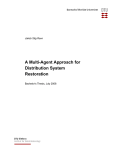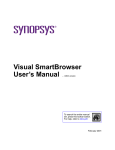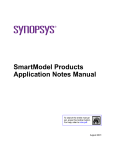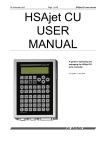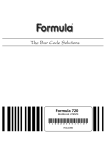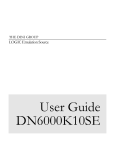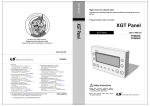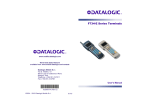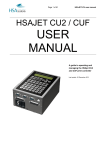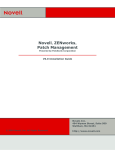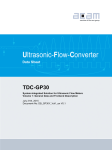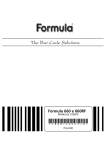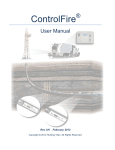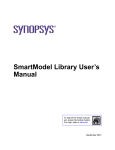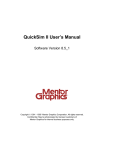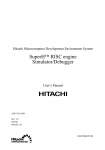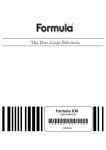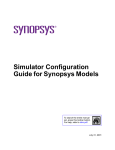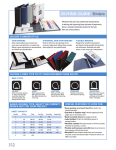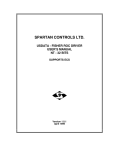Download Visual SmartBrowser User`s Manual (NT Version)
Transcript
Visual SmartBrowser User’s Manual – NT version To search the entire manual set, press this toolbar button. For help, refer to intro.pdf. February 2001 Visual SmartBrowser User’s Manual – NT version Copyright © 2001 Synopsys, Inc. All rights reserved. Printed in USA. Information in this document is subject to change without notice. SmartModel, ModelAccess, ModelTools, SourceModel Library, LM-1200, and Synopsys Eaglei are registered trademarks; MemPro, MemSpec, MemScope, FlexModel, LM-family, LM-1400, Logic Model, ModelSource, and SourceModel are trademarks of Synopsys, Inc. All company and product names are trademarks or registered trademarks of their respective owners. 2 Synopsys, Inc. February 2001 Visual SmartBrowser User’s Manual – NT version Contents Contents Preface . . . . . . . . . . . . . . . . . . . . . . . . . . . . . . . . . . . . . . . . . . . . . . . . . . . . . . . . . . . . . . About This Manual . . . . . . . . . . . . . . . . . . . . . . . . . . . . . . . . . . . . . . . . . . . . . . . . . . Related Documents . . . . . . . . . . . . . . . . . . . . . . . . . . . . . . . . . . . . . . . . . . . . . . . Manual Overview . . . . . . . . . . . . . . . . . . . . . . . . . . . . . . . . . . . . . . . . . . . . . . . . Typographical and Symbol Conventions . . . . . . . . . . . . . . . . . . . . . . . . . . . . . . . Getting Help . . . . . . . . . . . . . . . . . . . . . . . . . . . . . . . . . . . . . . . . . . . . . . . . . . . . . . . The Synopsys Website . . . . . . . . . . . . . . . . . . . . . . . . . . . . . . . . . . . . . . . . . . . . Synopsys Common Licensing (SCL) Document Set . . . . . . . . . . . . . . . . . . . . Comments? . . . . . . . . . . . . . . . . . . . . . . . . . . . . . . . . . . . . . . . . . . . . . . . . . . . . . . . 7 7 7 8 8 9 10 10 10 Chapter 1 VSB Overview . . . . . . . . . . . . . . . . . . . . . . . . . . . . . . . . . . . . . . . . . . . . . . . . . . . . . . . Introduction . . . . . . . . . . . . . . . . . . . . . . . . . . . . . . . . . . . . . . . . . . . . . . . . . . . . . . . Multiple Views . . . . . . . . . . . . . . . . . . . . . . . . . . . . . . . . . . . . . . . . . . . . . . . . . . . . Main Window . . . . . . . . . . . . . . . . . . . . . . . . . . . . . . . . . . . . . . . . . . . . . . . . . . . . . View and Tool Buttons . . . . . . . . . . . . . . . . . . . . . . . . . . . . . . . . . . . . . . . . . . . . . . View Control Pane . . . . . . . . . . . . . . . . . . . . . . . . . . . . . . . . . . . . . . . . . . . . . . . Status Bar . . . . . . . . . . . . . . . . . . . . . . . . . . . . . . . . . . . . . . . . . . . . . . . . . . . . . . Zoom Levels . . . . . . . . . . . . . . . . . . . . . . . . . . . . . . . . . . . . . . . . . . . . . . . . . . . Hierarchy View . . . . . . . . . . . . . . . . . . . . . . . . . . . . . . . . . . . . . . . . . . . . . . . . . Connection View . . . . . . . . . . . . . . . . . . . . . . . . . . . . . . . . . . . . . . . . . . . . . . . . Views and Tools . . . . . . . . . . . . . . . . . . . . . . . . . . . . . . . . . . . . . . . . . . . . . . . . . . . Hierarchy View . . . . . . . . . . . . . . . . . . . . . . . . . . . . . . . . . . . . . . . . . . . . . . . . . Hierarchy View Pop-Up Menu . . . . . . . . . . . . . . . . . . . . . . . . . . . . . . . . . . . . . Hierarchy View Tool Bar . . . . . . . . . . . . . . . . . . . . . . . . . . . . . . . . . . . . . . . . . . Connection View . . . . . . . . . . . . . . . . . . . . . . . . . . . . . . . . . . . . . . . . . . . . . . . . Connection View Pop-Up Menu . . . . . . . . . . . . . . . . . . . . . . . . . . . . . . . . . . . . Connection View Tool Bar . . . . . . . . . . . . . . . . . . . . . . . . . . . . . . . . . . . . . . . . Examine View . . . . . . . . . . . . . . . . . . . . . . . . . . . . . . . . . . . . . . . . . . . . . . . . . . Examine View Pop-Up Menu . . . . . . . . . . . . . . . . . . . . . . . . . . . . . . . . . . . . . . Global Selection Tool . . . . . . . . . . . . . . . . . . . . . . . . . . . . . . . . . . . . . . . . . . . . Net Tags Tool . . . . . . . . . . . . . . . . . . . . . . . . . . . . . . . . . . . . . . . . . . . . . . . . . . . Windows & Monitors Tool . . . . . . . . . . . . . . . . . . . . . . . . . . . . . . . . . . . . . . . . Creating and Editing Buses . . . . . . . . . . . . . . . . . . . . . . . . . . . . . . . . . . . . . . . . Specifying Illegal Characters . . . . . . . . . . . . . . . . . . . . . . . . . . . . . . . . . . . . . . . 11 11 13 15 18 19 19 20 20 21 23 23 25 27 29 32 34 36 38 39 42 44 47 49 February 2001 Synopsys, Inc. 3 Contents Visual SmartBrowser User’s Manual – NT version Visualizing a Setup or Hold Violation . . . . . . . . . . . . . . . . . . . . . . . . . . . . . . . . Visualizing a Cause Report from a Simulation Run . . . . . . . . . . . . . . . . . . . . . Visualizing an Effect Report from a Simulation Run . . . . . . . . . . . . . . . . . . . . Using Traces from a Simulation Run in Causal Trace . . . . . . . . . . . . . . . . . . . Viewing and Editing Instance Timing and Initial State Values . . . . . . . . . . . . . Selecting Circuit Objects . . . . . . . . . . . . . . . . . . . . . . . . . . . . . . . . . . . . . . . . . . Menu Commands . . . . . . . . . . . . . . . . . . . . . . . . . . . . . . . . . . . . . . . . . . . . . . . . . . File Menu . . . . . . . . . . . . . . . . . . . . . . . . . . . . . . . . . . . . . . . . . . . . . . . . . . . . . . Options Menu . . . . . . . . . . . . . . . . . . . . . . . . . . . . . . . . . . . . . . . . . . . . . . . . . . View Menu . . . . . . . . . . . . . . . . . . . . . . . . . . . . . . . . . . . . . . . . . . . . . . . . . . . . Tools Menu . . . . . . . . . . . . . . . . . . . . . . . . . . . . . . . . . . . . . . . . . . . . . . . . . . . . Window Menu . . . . . . . . . . . . . . . . . . . . . . . . . . . . . . . . . . . . . . . . . . . . . . . . . . 50 51 52 53 54 55 55 55 55 56 56 56 Chapter 2 Learning Visual SmartBrowser . . . . . . . . . . . . . . . . . . . . . . . . . . . . . . . . . . . . . . . . . Introduction . . . . . . . . . . . . . . . . . . . . . . . . . . . . . . . . . . . . . . . . . . . . . . . . . . . . . . . Setting Up the Tutorial . . . . . . . . . . . . . . . . . . . . . . . . . . . . . . . . . . . . . . . . . . . . . . Using the VSB . . . . . . . . . . . . . . . . . . . . . . . . . . . . . . . . . . . . . . . . . . . . . . . . . . . . . Identifying Hierarchical and SCV Instances . . . . . . . . . . . . . . . . . . . . . . . . . . . Determining the Scope of an Instance . . . . . . . . . . . . . . . . . . . . . . . . . . . . . . . . Creating a Sparse Hierarchy . . . . . . . . . . . . . . . . . . . . . . . . . . . . . . . . . . . . . . . Using Global Selection . . . . . . . . . . . . . . . . . . . . . . . . . . . . . . . . . . . . . . . . . . . Working with Circuit Object Tips . . . . . . . . . . . . . . . . . . . . . . . . . . . . . . . . . . . Visually Identifying Nets with Net Tags . . . . . . . . . . . . . . . . . . . . . . . . . . . . . . Defining Windows and Monitors . . . . . . . . . . . . . . . . . . . . . . . . . . . . . . . . . . . Saving Model Control Files (MCFs) . . . . . . . . . . . . . . . . . . . . . . . . . . . . . . . . . Changing Window Views . . . . . . . . . . . . . . . . . . . . . . . . . . . . . . . . . . . . . . . . . 57 57 57 59 64 66 68 68 70 72 75 78 78 Index . . . . . . . . . . . . . . . . . . . . . . . . . . . . . . . . . . . . . . . . . . . . . . . . . . . . . . . . . . . . . . . 81 4 Synopsys, Inc. February 2001 Visual SmartBrowser User’s Manual – NT version Figures Figures Figure 1: Figure 2: Figure 3: Figure 4: Figure 5: Figure 6: Figure 7: Figure 8: Figure 9: Figure 10: Figure 11: Figure 12: Figure 13: Figure 14: Figure 15: Figure 16: Figure 17: Figure 18: Figure 19: Figure 20: PLdebug Tools . . . . . . . . . . . . . . . . . . . . . . . . . . . . . . . . . . . . . . . . . . . . . . Various VSB Views and Tools . . . . . . . . . . . . . . . . . . . . . . . . . . . . . . . . . VSB Main Window . . . . . . . . . . . . . . . . . . . . . . . . . . . . . . . . . . . . . . . . . . View and Tool Buttons . . . . . . . . . . . . . . . . . . . . . . . . . . . . . . . . . . . . . . . View Control Pane . . . . . . . . . . . . . . . . . . . . . . . . . . . . . . . . . . . . . . . . . . Status Bar . . . . . . . . . . . . . . . . . . . . . . . . . . . . . . . . . . . . . . . . . . . . . . . . . Zoom Control Buttons . . . . . . . . . . . . . . . . . . . . . . . . . . . . . . . . . . . . . . . . Hierarchy View . . . . . . . . . . . . . . . . . . . . . . . . . . . . . . . . . . . . . . . . . . . . . Hierarchy View Pop-Up Menu . . . . . . . . . . . . . . . . . . . . . . . . . . . . . . . . . Hierarchy View Tool Bar Buttons . . . . . . . . . . . . . . . . . . . . . . . . . . . . . . . Connection View . . . . . . . . . . . . . . . . . . . . . . . . . . . . . . . . . . . . . . . . . . . . Connection View Pop-Up Menu . . . . . . . . . . . . . . . . . . . . . . . . . . . . . . . . Connection View Tool Bar Buttons . . . . . . . . . . . . . . . . . . . . . . . . . . . . . Examine View Window . . . . . . . . . . . . . . . . . . . . . . . . . . . . . . . . . . . . . . . Examine View Pop-Up Menu . . . . . . . . . . . . . . . . . . . . . . . . . . . . . . . . . . Global Selection Tool . . . . . . . . . . . . . . . . . . . . . . . . . . . . . . . . . . . . . . . . Net Tags Tool . . . . . . . . . . . . . . . . . . . . . . . . . . . . . . . . . . . . . . . . . . . . . . Windows & Monitors Tool . . . . . . . . . . . . . . . . . . . . . . . . . . . . . . . . . . . . Creating Buses in Windows & Monitors Tool . . . . . . . . . . . . . . . . . . . . . Causal Trace Tool . . . . . . . . . . . . . . . . . . . . . . . . . . . . . . . . . . . . . . . . . . . February 2001 Synopsys, Inc. 12 13 15 18 19 19 20 23 25 27 29 32 34 36 38 39 42 44 47 54 5 Figures 6 Visual SmartBrowser User’s Manual – NT version Synopsys, Inc. February 2001 L Visual SmartBrowser User’s Manual – NT version Preface Preface About This Manual This manual contains reference information for SmartModel Library users who are on an NT platform. If you are on UNIX, refer to the Visual SmartBrowser User’s Manual – UNIX version – since the NT version of the Visual SmartBrowser (VSB) tool operates somewhat differently from the UNIX version. The focus of this manual is on how to use the VSB tool to improve productivity when working with SmartCircuit models of FPGA and CPLD devices. The manual does not contain general information about SmartCircuit models or other types of SmartModel Library models—that information is presented in the SmartModel Library User’s Manual. For an application note that describes how to use VSB and the other SmartCircuit debugging tools together to solve verification problems, refer to the SmartModel Products Application Notes Manual. Related Documents For general information about SmartModel Library documentation, or to navigate to a different online document, refer to the Guide to SmartModel Documentation. For the latest information on supported platforms and simulators, refer to SmartModel Library Supported Simulators and Platforms. For detailed information about specific models in the SmartModel Library, use the Browser tool ($LMC_HOME/bin/sl_browser) to access the online model datasheets. February 2001 Synopsys, Inc. 7 L Visual SmartBrowser User’s Manual Preface – NT version Manual Overview This manual contains the following chapters and appendixes: Preface Describes the manual and lists the typographical conventions and symbols used in it; tells how to get technical assistance. Chapter 1: VSB Overview Contains procedures for using the Visual SmartBrowser (VSB). Chapter 2: Learning Visual SmartBrowser Contains a short tutorial that enables new users to learn how to use the Visual SmartBrowser (VSB). Typographical and Symbol Conventions ● Default UNIX prompt Represented by a percent sign (%). ● User input (text entered by the user) Shown in bold type, as in the following command line example: % cd $LMC_HOME/hdl ● System-generated text (prompts, messages, files, reports) Shown as in the following system message: No Mismatches: 66 Vectors processed: 66 Possible ● Variables for which you supply a specific value Shown in italic type, as in the following command line example: % setenv LMC_HOME prod_dir In this example, you substitute a specific name for prod_dir when you enter the command. ● Command syntax Choice among alternatives is shown with a vertical bar ( | ) as in the following syntax example: -effort_level low | medium | high In this example, you must choose one of the three possibilities: low, medium, or high. 8 Synopsys, Inc. February 2001 L Visual SmartBrowser User’s Manual – NT version Preface Optional parameters are enclosed in square brackets ( [ ] ) as in the following syntax example: pin1 [pin2 ... pinN] In this example, you must enter at least one pin name (pin1), but others are optional ([pin2 ... pinN]). Getting Help If you have a question while using Synopsys products, use the following resources: 1. Start with the available product documentation installed on your network or located at the root level of your Synopsys CD-ROM. Every documentation set contains overview information in the intro.pdf file. Additional Synopsys documentation is available at this URL: http://www.synopsys.com/products/lm/doc Datasheets for models are available using the Model Directory: http://www.synopsys.com/products/lm/modelDir.html 2. Visit the online Support Center at this URL: http://www.synopsys.com/support/lm/support.html This site gives you access to the following resources: ❍ SOLV-IT!, the Synopsys automated problem resolution system ❍ product-specific FAQs (frequently asked questions) ❍ lists of supported simulators and platforms ❍ the ability to open a support help call ❍ the ability to submit a delivery request for some product lines 3. If you still have questions, you can call the Support Center: North American customers: Call the Synopsys Eaglei and Logic Modeling Products Support Center hotline at 1-800-445-1888 (or 1-503-748-6920) from 6:30 AM to 5 PM Pacific Time, Monday through Friday. International customers: Call your local sales office. February 2001 Synopsys, Inc. 9 Preface L Visual SmartBrowser User’s Manual – NT version The Synopsys Website General information about Synopsys and its products is available at this URL: http://www.synopsys.com Synopsys Common Licensing (SCL) Document Set Synopsys common licensing (SCL) software is delivered on a CD that is separate from the tools that use this software to authorize their use. The SCL documentation set includes the following publications, which are located in (root)/docs/scl on the SCL CD and also available on the Synopsys FTP server (ftp://ftp.synopsys.com): ● Licensing QuickStart—(142K PDF file) This booklet provides instructions for obtaining an electronic copy of your license key file and for installing and configuring SCL on UNIX and Windows NT. ● Licensing Installation and Administration Guide—(2.08M PDF file) This guide provides information about installation and configuration, key concepts, examples of license key files, migration to SCL, maintenance, and troubleshooting. You can find general SCL information on the Web at: http://www.synopsys.com/keys Comments? To report errors or make suggestions, please send e-mail to: [email protected] To report an error that occurs on a specific page, select the entire page (including headers and footers), and copy to the buffer. Then paste the buffer to the body of your e-mail message. This will provide us with information to identify the source of the problem. 10 Synopsys, Inc. February 2001 L Visual SmartBrowser User’s Manual – NT version Chapter 1: VSB Overview 1 VSB Overview This chapter presents information on how to use the VSB tool to improve productivity when working with SmartCircuit models. This information is organized in the following major sections: ● Multiple Views ● Main Window ● View and Tool Buttons ● Views and Tools Introduction Visual SmartBrowser (VSB) is a tool with a graphical user interface that you can use to debug designs that incorporate SmartCircuit models of FPGA and CPLD devices. VSB uses multiple different views of a device netlist to enable accurate diagnosis of design problems. VSB is part of a suite of SmartCircuit PLdebug tools that enable you to determine relationships within your design, as illustrated in Figure 1. The PLdebug tools are: ● SmartCircuit Monitor. Enables you to observe any element in your design and receive reports of any changes that occur on that element. ● Causal Tracing. Enables you to trace events in a simulation to see where a problem is occurring or to trace the causes of a problem to their roots. ● SmartBrowser interactive tool. Enables you to traverse a design and obtain information about any element in the design; has a batch mode. February 2001 Synopsys, Inc. 11 L Visual SmartBrowser User’s Manual Chapter 1: VSB Overview ● – NT version Visual SmartBrowser. Graphically enables you to traverse a design for information on the design elements; does not have a batch mode. PL debug Tools SmartCircuit Monitor Causal Tracing SmartBrowser Interactive Tool Visual SmartBrowser Figure 1: PLdebug Tools Both the SmartBrowser interactive tool and the VSB enable you to find information about the elements in a design. The VSB gives a visual conceptualization of the design, whereas the SmartBrowser gives no visual clues to the design. Whether you should use the SmartBrowser or the Visual SmartBrowser is primarily a question of preference and possibly circumstances, such as the size of your design. For more information on SmartCircuit models, SmartCircuit monitors, causal tracing, or the non-graphical SmartBrowser interactive tool, refer to the SmartModel Library User’s Manual. 12 Synopsys, Inc. February 2001 L Visual SmartBrowser User’s Manual – NT version Chapter 1: VSB Overview Multiple Views Visual SmartBrowser reads a post-layout netlist (in the SmartCircuit .ccn format) and represents the design in various graphical views as illustrated in Figure 2. Figure 2: Various VSB Views and Tools February 2001 Synopsys, Inc. 13 Chapter 1: VSB Overview L Visual SmartBrowser User’s Manual – NT version ● Hierarchy View. View the design as a tree-like structure of hierarchical blocks. ● Connection View. Expand and collapse circuit connections selectively. This demand-driven approach has several benefits: ❍ Eliminates the need to display the entire schematic, reducing processing time ❍ Clears the designer’s view of unrelated nets and other circuit objects ❍ Shows how the semiconductor vendor (SCV) cells are actually connected without the need to move up and down through the hierarchy ● Examine View. View an instance in detail and edit any timing or state information. ● Windows & Monitors tool. Create model command files (MCFs) for windowing and monitoring internal nets and states during simulation. & Note Throughout this manual and the rest of the SmartModel Library documentation, the term “instance” may mean: 1) the device itself, 2) any of the hierarchy blocks making up the device, or 3) the vendor’s library cell (leaf node). The surrounding text determines which usage is intended. 14 Synopsys, Inc. February 2001 L Visual SmartBrowser User’s Manual – NT version Chapter 1: VSB Overview Main Window The Main window is the “command center” from which you control the Visual SmartBrowser. Figure 3 illustrates the main window, which contains the following elements: ● Menu bar ● Buttons to open the various views and tools ● View control pane with icons for all open views ● Optional status bar Menu bar Buttons for views and tools View control pane Status bar Figure 3: VSB Main Window Opening a Design To open a design, include its file name on the command line when you start the Visual SmartBrowser, as shown in the following example: %$LMC_HOME%\bin\vsb design.ccn February 2001 Synopsys, Inc. 15 Chapter 1: VSB Overview L Visual SmartBrowser User’s Manual – NT version There is also a menu command that you can use to open a design belonging to the same model, or re-open the current design (to toss any changes you may have made). 1. Choose File > Open, or press Ctrl+O. 2. Double-click on the netlist (.ccn) file you want to open. & Note Tools like VSB are “model-centric.” This means that the model you are using determines the correct version of the tool to use for that particular model version. Since the model name (for example, a1425_84) has already been embedded into the .ccn file by smartccn, we recommend that you invoke VSB on the command line by specifying the design.ccn, as shown in the preceding example. Displaying an Instance To display the top-level (design) instance, click on the Create Hierarchy View button. Viewing a Circuit Object To view a circuit object in Hierarchy, Connection, or Examine View, follow these steps: 1. Select the net, port, or instance in an active view or tool. 2. In the main window, click on the corresponding view or tool button. You can also choose the corresponding command from the View or Tools menu. Toggling the Status Bar To toggle the display of the status bar in the main window, choose the following menu item: Options > Status Bar Toggling Tool or Circuit Object Tips To toggle the display of tool tips or circuit object tips in the main window, choose the following menu item: Options > Show Tool Tips Options > Show Circuit Object Tips 16 Synopsys, Inc. February 2001 L Visual SmartBrowser User’s Manual – NT version Chapter 1: VSB Overview Bringing a View to the Foreground To bring a view to the foreground, click on the corresponding icon in the view control pane. You can also choose the view by name from the Window menu. If necessary, you can click on the right and left arrow buttons to scroll more view icons into the view control pane. Raising and Iconifying Views To raise or iconify all views, choose the following menu entries: Window > Raise All Views Window > Iconify All Views Creating a Sparse Hierarchy View To create a sparse hierarchy view, follow these steps: 1. If necessary, bring the appropriate Connection View to the foreground. 2. In the Connection View, use the Expand Selection, Collapse Selection, Hide Selected Circuit Object, and/or Hide Unconnected Circuit Objects tools to display the instances and ports of interest. 3. Click on the Create Sparse Hierarchy button. A new Hierarchy View displays just the portion of the design hierarchy that contains the ports and instances in the active Connection View. Creating a Model Command File (MCF) To create a model command file (MCF), follow these steps: 1. Click on the Show Windows & Monitors Tool button. 2. Specify the nets, states, and buses you want to window or monitor. 3. Click on the Save To File button. For detailed instructions, refer to “Windows & Monitors Tool” on page 44. February 2001 Synopsys, Inc. 17 L Visual SmartBrowser User’s Manual Chapter 1: VSB Overview – NT version View and Tool Buttons You can use the Visual SmartBrowser’s view and tool buttons to view a design netlist in several different ways. Figure 4 illustrates the view and tool buttons used in VSB. Examine View Connection View Hierarchy View Net Tags Global Selection Causal Trace Windows & Monitors Figure 4: View and Tool Buttons 18 ● Create Hierarchy View. Opens a Hierarchy View based on the selected circuit object. (Same as View > Create Hierarchy View.) ● Create Connection View. Opens a Connection View based on the selected circuit object. (Same as View > Create Connection View.) ● Create Examine View. Opens an Examine View based on the selected circuit object. In this view you can see and edit timing and initial state values, along with other details about the selected object. (Same as View > Create Examine View.) ● Show Global Selection Tool. Opens the Global Selection tool, in which you can select nets, ports, and model instances by name. (Same as Tools > Show Global Selection Tool.) ● Show Net Tags Tool. Opens the Net Tags tool, in which you can tag nets. Tags are represented by different colors to make them easier to see. (Same as Tools > Show Net Tags Tool.) ● Show Windows & Monitors Tool. Opens the Windows & Monitors tool, which you can use to set up windows and monitors for nets, states, and buses. (Same as Tools > Show Windows & Monitors Tool.) ● Causal Trace. Opens a Causal Trace window, which you can use to cut-and-paste portions of your simulation output when you need to see cause reports in the LMC Model Trace output. Synopsys, Inc. February 2001 L Visual SmartBrowser User’s Manual – NT version Chapter 1: VSB Overview View Control Pane The view control pane is illustrated in Figure 5. You can click on any icon in the view control pane to bring the corresponding view to the foreground. Click on the left and right arrow buttons to scroll through the view control pane. View control pane Figure 5: View Control Pane Status Bar The status bar displays the name, type, and scope of the selected net, port, or instance, as illustrated in Figure 6. It also shows the state of the VSB tool, the current zoom level, and whether the active design has been modified. Status bar Figure 6: Status Bar February 2001 Synopsys, Inc. 19 L Visual SmartBrowser User’s Manual Chapter 1: VSB Overview – NT version Toggling the Status Bar Display To toggle the status bar display, follow these steps: ● In the main window, choose Options > Status Bar. ● In a Hierarchy View or Connection View, do one of the following: ❍ Choose View > Status Bar. ❍ Click the right mouse button, and then choose View Controls > Status Bar. Zoom Levels You can use the zoom control buttons from the hierarchy and connections views to see different levels of detail, as shown in Figure 7. Figure 7: Zoom Control Buttons Hierarchy View In the hierarchy view, each port is labeled with its name and direction (for example, I, O, or I/O). For the root (design) instance, symbol pin names are shown in parentheses next to the port names. The zoom buttons work as follows: 20 ● Zoom Detail. Each instance is labeled with its name and cell type, and the number of contained instances and semiconductor vendor (SCV) cells. ● Zoom High. Each instance is labeled with its name and cell type. ● Zoom Medium. Each instance is labeled with its name and cell type. ● Zoom Low. Instances are not labeled, but circuit object tips show the name and cell type of each instance. In this view, more of the hierarchy is visible, so it is easier to see the overall topology and move about the instance tree. Synopsys, Inc. February 2001 L Visual SmartBrowser User’s Manual – NT version Chapter 1: VSB Overview Connection View In the Connection View, the zoom buttons work as follows: ● ● ● ● Detail. ❍ Each port of a hierarchical block is labeled with its name and direction (for example, I, O, or I/O). For the root (design) instance, symbol pin names are shown in parentheses beside the port names. ❍ Each SCV instance is labeled with its name and cell type. Input ports are shown on the left side of the instance and output ports are shown on the right. ❍ Each port on an SCV instance is labeled with its name. ❍ Circuit object tips show the names of net connections. High. ❍ Each port of a hierarchical block is labeled with its name and direction (for example, I, O, or I/O). For the root (design) instance, symbol pin names are shown in parentheses beside the port names. ❍ Each SCV instance is labeled with its name and cell type. ❍ Ports on SCV instances are not labeled. ❍ Circuit object tips show the names of net connections. Medium. ❍ Ports are not labeled, but circuit object tips show the names of ports on hierarchical blocks. ❍ Each SCV instance is labeled with its cell type, and circuit object tips show the names of instances. ❍ Circuit object tips show the names of net connections. Low. ❍ Ports are not labeled, but circuit object tips show the names of ports on hierarchical blocks. ❍ SCV instances are not labeled, but circuit object tips show the name and cell type of each instance. ❍ Net connections are not displayed, but more of the Connection View is visible. February 2001 Synopsys, Inc. 21 Chapter 1: VSB Overview L Visual SmartBrowser User’s Manual – NT version Setting the Zoom Level To set the zoom level, do one of the following: ● From the tool bar, click on a zoom level icon. ● With the right mouse button: a. In the Hierarchy View or the Connection View, click the right mouse button and select the Zoom command from the pop-up menu. b. Choose a zoom level from the menu. 22 Synopsys, Inc. February 2001 L Visual SmartBrowser User’s Manual – NT version Chapter 1: VSB Overview Views and Tools This section discusses the various VSB views and tools. Hierarchy View The Hierarchy View window displays the hierarchical location of the instances in a design, as illustrated in Figure 8. The root instance is the design itself. The semiconductor vendor (SCV) cells are located at the leaf nodes of a fully expanded branch. Thus, a flat netlist has two levels: one for the design and one for all the SCV cells. Hierarchy pane Tool bar Design instance Port pane Status bar Figure 8: Hierarchy View February 2001 Synopsys, Inc. 23 Chapter 1: VSB Overview L Visual SmartBrowser User’s Manual – NT version The Hierarchy View also contains a tool bar for common tasks and a list of ports (I=input, O=output, I/O=bidirectional) for the selected instance. For the root (design) instance, symbol pin names are shown in parentheses beside the port names. You can use any port as a starting point for the generation of a new Connection View. At the bottom of the Hierarchy View is an optional status bar. Expanding a Hierarchical Block To expand a hierarchical block, do one of the following: ● By selection: a. In the hierarchy pane, select a non-leaf instance. b. Click on the Expand Selection tool. ● By double-clicking on a non-leaf instance in the hierarchy pane. Collapsing a Hierarchical Block To collapse a hierarchical block, do one of the following: ● By selection: a. In the hierarchy pane, select an expanded instance. b. Click on the Collapse Selection tool. ● By double-clicking on the expanded instance. Exploring Connections from a Port To explore connections from a port, do one of the following: ● By selection: a. From the list below the hierarchy pane, select the port. b. In the main window, click on the Create Connection View button. ● By double-clicking on the port in the list. A new Connection View displays the selected port or SCV instance. 24 Synopsys, Inc. February 2001 L Visual SmartBrowser User’s Manual – NT version Chapter 1: VSB Overview Displaying Instance Details To display details on an instance, do one of the following: ● By selection: a. In the hierarchy pane, select the instance. b. In the main window, click on the Create Examine View button. ● By double-clicking on a leaf (SCV) instance in the hierarchy pane. In Examine View, you can also modify timing and initial state values for circuit objects that include timing and state information. Displaying the Top-Level Instance To display the top-level (design) instance, follow these steps: 1. In the Hierarchy View or Connection View, click on the selected circuit object (or on any unoccupied space) to cancel the current selection. 2. Click on the Create Hierarchy View button. Hierarchy View Pop-Up Menu You can use the Hierarchy View pop-up menu to perform various functions as shown in Figure 9. Figure 9: Hierarchy View Pop-Up Menu February 2001 Synopsys, Inc. 25 Chapter 1: VSB Overview L Visual SmartBrowser User’s Manual – NT version ● Raise Application Shell Window. Brings the VSB main window to the top. ● Zoom. Displays several zoom levels. ● ❍ Detail. Each instance is labeled with its name and cell type, and the number of contained instances and semiconductor vendor (SCV) cells. ❍ High. Each instance is labeled with its name and cell type. ❍ Medium. Each instance is labeled with its name and cell type. ❍ Low. Instances are not labeled, but circuit object tips show the name and cell type of each instance. In this view, more of the hierarchy is visible, so it is easier to see the overall topology and move about the instance tree. View Controls: ❍ Toolbar. Toggles display of the tool bar in the active Hierarchy View. ❍ Status Bar. Toggles display of status information in the active Hierarchy View. ❍ Iconify. Reduces the active Hierarchy View to an icon. ❍ Close this View. Closes the active Hierarchy View. (Same as the Close View tool on the Hierarchy View Tool Bar.) ● Expand. Shows the hierarchy under the selected instance. (Same as the Expand Selection tool on the Hierarchy View Tool Bar.) ● Collapse. Hides the hierarchy under the selected instance. (Same as the Collapse Selection tool on the Hierarchy View Tool Bar.) ● Find. Centers the selected circuit object in the active Hierarchy View, if the view contains the object. Use this command after you select an object in another view or tool. (Same as the Find Selection tool on the Hierarchy View Tool Bar.) ● 26 Auto Find Selection. When possible, updates the active Hierarchy View automatically to focus on the selected object. Synopsys, Inc. February 2001 L Visual SmartBrowser User’s Manual – NT version Chapter 1: VSB Overview Hierarchy View Tool Bar Figure 10 illustrates the tool bar buttons available in the Hierarchy View. t Change zoom buttons Collapse button Expand button Close the view Find button Figure 10: Hierarchy View Tool Bar Buttons ● Zoom Detail. Each instance is labeled with its name and cell type, and the number of contained instances and semiconductor vendor (SCV) cells. ● Zoom High. Each instance is labeled with its name and cell type. ● Zoom Medium. Each instance is labeled with its name and cell type. ● Zoom Low. Instances are not labeled, but circuit object tips show the name and cell type of each instance. ● Expand Selection. Shows the hierarchy under the selected instance. (Same as the Expand command on the Hierarchy View Pop-Up Menu.) ● Collapse Selection. Hides the hierarchy under the selected instance. (Same as the Collapse command on the Hierarchy View Pop-Up Menu.) February 2001 Synopsys, Inc. 27 Chapter 1: VSB Overview 28 L Visual SmartBrowser User’s Manual – NT version ● Find. Centers the selected object in the active Hierarchy View, if the view contains the object. Use this command after you select an object in another view or tool. (Same as the Find command on the Hierarchy View Pop-Up Menu.) ● Close. Closes the active Hierarchy View. (Same as the Close this View command on the Hierarchy View Pop-Up Menu.) Synopsys, Inc. February 2001 L Visual SmartBrowser User’s Manual – NT version Chapter 1: VSB Overview Connection View In the Connection View (shown in Figure 11), you can trace connections through the design. Select a port or a semiconductor vendor (SCV) instance and click on the Create Connection View button to view associated input and output connections. Connection pane Tool bar Status bar Figure 11: Connection View February 2001 Synopsys, Inc. 29 Chapter 1: VSB Overview L Visual SmartBrowser User’s Manual – NT version In the Connection View, ports on an instance include the following visual clues: ● A circle in the port indicates inverted input or output. ● Violet ports are connected to power and green ports are connected to ground. The Connection View also contains a tool bar for common tasks and an optional status bar. Showing Port Drivers or Receivers To show port drivers or receivers, do one of the following: ● By selection: a. In Connection View, select the port. b. Click on the Expand tool. ● By double-clicking on the port in Connection View. You can continue expanding connections until you reach an SCV device pin. & Note An unconnected port displays no net connections when expanded. Hiding Expanded Port Connections To hide an expanded port's connections, do one of the following: ● By selection: a. In Connection View, select the port. b. Click on the Collapse tool. ● By double-clicking on the expanded port. Note that the disconnected objects remain visible—to hide them, click on the Hide Unconnected Objects tool. 30 Synopsys, Inc. February 2001 L Visual SmartBrowser User’s Manual – NT version Chapter 1: VSB Overview Hiding Individual Net Connections To hide an individual net connection, select the net and click on the Hide Selected Object tool (or press Delete). Showing an Instance in the Connection View To show an instance in the active Connection View, select the instance and choose Add Current Selection from the Connection View pop-up menu. Undoing a Wide Fan-In or Fan-Out To undo a wide fan-in or fan-out, follow these steps: 1. Select the net into or out of the expanded port. 2. Click on the Hide Selected Object tool (or press Delete). 3. Click on the Hide Unconnected Circuit Objects tool. Creating a Sparse Hierarchy View To create a sparse Hierarchy View, follow these steps: 1. Use the Expand Selection, Collapse Selection, Hide Selected Circuit Object, and/or Hide Unconnected Circuit Objects tools to display the instances and ports of interest. 2. Click on the Create Sparse Hierarchy button. A new Hierarchy View displays just the portion of the design hierarchy that contains the ports and instances in the active Connection View. February 2001 Synopsys, Inc. 31 Chapter 1: VSB Overview L Visual SmartBrowser User’s Manual – NT version Connection View Pop-Up Menu You can use the Connection View pop-up menu shown in Figure 12 to perform several functions. Figure 12: Connection View Pop-Up Menu ● Raise Application Shell Window. Brings the VSB main window to the top. ● Zoom. Displays several zoom levels: detail, high, medium, and low. (Similar to the Zoom tools on the Connection View Tool Bar.) ● View Controls: ● 32 ❍ Toolbar. Toggles display of the tool bar in the active Connection View. ❍ Status Bar. Toggles display of status information in the active Connection View. ❍ Iconify. Reduces the active Connection View to an icon. ❍ Close. Closes the active Connection View. (Same as the Close tool on the Connection View Tool Bar.) Expand. Shows the connections from the selected port. (Same as the Expand tool on the Connection View Tool Bar.) Synopsys, Inc. February 2001 L Visual SmartBrowser User’s Manual – NT version Chapter 1: VSB Overview ● Collapse. Hides the connections from the selected port. Note that the disconnected objects remain visible—to hide them, click the Hide Unconnected Objects tool. (Same as the Collapse tool on the Connection View Tool Bar.) ● Find Current Selection. Centers the selected circuit object in the active Connection View, if the view contains the object. Use this command after you select an object in another view or tool. (Same as the Find tool on the Connection View Tool Bar.) ● Add Current Selection. Adds an instance, selected in some other view, to the active Connection View. ● Auto Find Selection. When possible, automatically updates the active Connection View to focus on the selected object. ● Create Sparse Hierarchy View. Displays a portion of the design hierarchy containing just the objects in the active Connection View. ● Hide Unconnected Objects. Hides objects in the active Connection View that are not connected to any other object in the view. You can use this command to prepare for creating a sparse hierarchy view. ● Hide Selected Object. Hides the selected object in the active Connection View. You can use this command to prepare for creating a sparse hierarchy view. ● Show Scope Paths. Displays (below each instance) the path to the instance from the root of the design. February 2001 Synopsys, Inc. 33 L Visual SmartBrowser User’s Manual Chapter 1: VSB Overview – NT version Connection View Tool Bar Figure 13 illustrates the tool bar buttons available in the Connection View. Change Zoom Buttons Collapse Selection Expand Selection Find Selection Create Sparse Hierarchy Hide Selected Circuit Object Hide Unconnected Circuit Object Close View Figure 13: Connection View Tool Bar Buttons 34 ● Zoom Detail. Each instance is labeled with its name and cell type, and the number of contained instances and semiconductor vendor (SCV) cells. ● Zoom High. Each instance is labeled with its name and cell type. ● Zoom Medium. Each instance is labeled with its name and cell type. ● Zoom Low. Instances are not labeled, but circuit object tips show the name and cell type of each instance. Synopsys, Inc. February 2001 L Visual SmartBrowser User’s Manual – NT version Chapter 1: VSB Overview ● Expand Selection. Shows the connections from the selected port. (Same as the Expand command on the Connection View Pop-Up Menu.) ● Collapse Selection. Hides the connections from the selected port. Note that the disconnected objects remain visible. (Same as the Collapse command on the Connection View Pop-Up Menu.) ● Find. Centers the selected object in the active Connection View, if the view contains the object. Use this command after you select an object in another view or tool. (Same as the Find Current Selection command on the Connection View Pop-Up Menu.) ● Create Sparse Hierarchy. Displays (in a new Hierarchy View) just the portion of the design hierarchy that contains objects visible in the active Connection View. ● Hide Selected Object. Hides the selected circuit object in the active Connection View. ● Hide Unconnected Objects. Hides circuit objects in the active Connection View that are not connected to any other object in the view. ● Close. Closes the active Connection View. (Same as the Close this View command on the Connection View Pop-Up Menu.) February 2001 Synopsys, Inc. 35 Chapter 1: VSB Overview L Visual SmartBrowser User’s Manual – NT version Examine View In the Examine View window, you can view and modify detailed information about model instances, as shown in Figure 14. Graphical pane State form button Timing form button Figure 14: Examine View Window Graphical Pane This area shows port names and the connected nets. Right- and left-pointing triangles indicate signal direction. Grey circles indicate port inversion. Power and ground labels are also visible. If the instance has timing or state information, the corresponding down arrow button (Timing Form or State Form, below the graphical pane) is enabled. Click on a down arrow button to show the corresponding form. When the Timing Form is visible, you can click on a port name in the graphical pane to highlight the timing parameters associated with that port. Timing Form The Timing Form contains a list of timing parameters on the left. Select a parameter to view the following information: 36 ● Name. The selected timing parameter. ● Description. A description of the timing parameter. Synopsys, Inc. February 2001 L Visual SmartBrowser User’s Manual – NT version Chapter 1: VSB Overview ● Timing Value Units. Specifies whether to display values in picoseconds, nanoseconds, microseconds, or milliseconds; select one. ● Values in .ccn File. The min, typ, and max values for the selected timing parameter, as stored in the .ccn file. ● Current Values. The min, typ, and max values for the selected timing parameter, as modified but not yet saved to the .ccn file. When the Timing Form is visible, you can click on a timing parameter in the parameter list to highlight the associated ports in the graphical pane. If you change the information on the Timing Form, click on the Accept Modification button to record your changes. State Form The State Form contains a list of states on the left. Select a state to view the following information: ● Name. The selected state. ● Description. A description of the selected state parameter. ● Value in .ccn File. The value of the selected state parameter, as stored in the .ccn file. ● Current Value. The value of the selected state parameter, as modified but not yet saved to the .ccn file. ● Bit Position. The offset of the last bit selected in the “Value in .ccn File” field. If the state contains more than one bit, a slider appears below the Bit Position field. Drag the slider, click on the right and left arrow buttons, or use the right and left arrow keys to select a different bit. To change a bit's value, select the bit and type the value you want it to have. Legal characters are 0, 1, x (unknown), u (uninitialized), z (high-impedance), and - (unspecified). If you change the information on the State Form, click on the Accept Modification button to record your changes. February 2001 Synopsys, Inc. 37 Chapter 1: VSB Overview L Visual SmartBrowser User’s Manual – NT version Examine View Pop-Up Menu You can use the Examine View pop-up menu shown in Figure 15 to perform several functions. Figure 15: Examine View Pop-Up Menu 38 ● Raise Application Shell Window. Brings the VSB main window to the top. ● View Controls: ❍ Iconify. Reduces the active Examine View to an icon. ❍ Close. Closes the active Examine View. Synopsys, Inc. February 2001 L Visual SmartBrowser User’s Manual – NT version Chapter 1: VSB Overview Global Selection Tool You can use the Global Selection dialog box to select an instance, net, or port by name. You can also open this dialog box to see which circuit object is the global selection, as shown in Figure 16. Scope of instance Object type: Ports Nets Instances Figure 16: Global Selection Tool If you know the name of the circuit object you want to select, type the name in the Circuit Object field and, if necessary, type the path to the circuit object in the Scope field. Make sure the Object Type selection is correct. If you know only a portion of the circuit object name or want to select from a list of objects, you can browse the design. Click on the Select Global button to select the specified instance, net, or port globally. The Browse Filter field recognizes regular expressions and presents a list of all instances that match the pattern you specify in the Browse Filter field. February 2001 Synopsys, Inc. 39 L Visual SmartBrowser User’s Manual Chapter 1: VSB Overview – NT version Browsing for an Object To browse for an object, follow these steps: 1. In the Scope field, type the path to the circuit object you want to select. 2. In the Browse Filter field, type part of the object name, or type a regular expression to specify one or more objects. 3. Click on the Browse Given Scope button (or press Enter while the Browse Filter field has the focus). Traversing the Hierarchy To traverse the hierarchy, follow these steps: 1. Set the Object Type to Instances. 2. Set the Browse Filter field as needed. 3. Click on the Browse Given Scope button. 4. To move down the design hierarchy, double-click on an instance in the list. 5. To move up the design hierarchy, double-click on the “double dots” (..) at the top of the list. & Note At the root of the design hierarchy, the list shows (Device: device-name), rather than the double dots. Regular Expressions Use the Browse Filter field and the Browse Given Scope button in the Global Selection tool to specify a character or string that appears anywhere in the found names; you can use standard regular expression syntax in the Browse Filter field. Matching a Character To match a character, use any of the following syntax in the Browse Filter field and press the Browse Given Scope button to activate it: \specChar Where specChar is one of the following: \ [ ] ^ - . ? + * Matches the character literally; the backslash “escapes” the special character. char Matches any other (non-special) character. 40 Synopsys, Inc. February 2001 L Visual SmartBrowser User’s Manual – NT version Chapter 1: VSB Overview [chars] Matches any of the characters in the brackets. [^chars] Matches any character except those in the brackets. [char1-char2] Matches any of the characters in the range char1 to char2. Examples: [a-z] [0-9] Matches any lowercase letter. Matches any digit. [^char1-char2] Matches any character outside the range char1 to char2. . (period) Matches any single character. ? (question mark) Matches an optional preceding element. Examples: ab?c a[a-z]?c Matches abc and ac. Matches ac, aac, abc, . . . , azc. Matching a String To match a string, use any of the following syntax in the Browse Filter field and press the Browse Given Scope button to activate it: + (plus sign) Matches one or more occurrences of the preceding element. For example: ab+c A[a-z]+ Matches abc, abbc, abbbc, and so on. Matches A followed by one or more lowercase letters. * (asterisk) Matches zero or more occurrences of the preceding element. For example: ab*c” X[123]* Matches ac, abc, abbc, abbbc, and so on. Matches X, optionally followed by any combination of 1s, 2s, and 3s. You can also concatenate regular expressions to create a string. For example, “A[a-z]+_Bus[0-9]*” matches A followed by one or more lowercase letters, then _Bus, then zero or more digits (such as Addr_Bus00 and Address_Bus). February 2001 Synopsys, Inc. 41 L Visual SmartBrowser User’s Manual Chapter 1: VSB Overview – NT version Net Tags Tool Use this Net Tags dialog box (shown in Figure 17) to tag specific nets and set the color of the nets in Connection View. Displaying different nets in different colors can make it easier to identify connection paths through a design. Figure 17: Net Tags Tool Tagging a Net To tag a net, follow these steps: 1. In the Net Tags tool, select a color. 2. In Connection View, select a net. While the pointer is a hand, every net you select is added to the list under the current color choice. 3. When you finish tagging nets, click on the current color choice again or close the Net Tags tool. 42 Synopsys, Inc. February 2001 L Visual SmartBrowser User’s Manual – NT version Chapter 1: VSB Overview Removing Tags from Nets To remove the tag from one or more nets, follow these steps: 1. In the Net Tags tool, select the nets to untag. 2. Click on the Clear Selected Net Tags button. To remove the tag from all the nets of a given color, click on the Clear List button under the corresponding color choice list. February 2001 Synopsys, Inc. 43 Chapter 1: VSB Overview L Visual SmartBrowser User’s Manual – NT version Windows & Monitors Tool You can use the Windows & Monitors dialog box (shown in Figure 18) to do the following: ● Designate nets, states, and buses for windowing or monitoring ● Create and modify buses and aliases ● Create model command files (MCFs) for simulation Bus elements button Cross-hair used to select bus elements Figure 18: Windows & Monitors Tool 44 Synopsys, Inc. February 2001 L Visual SmartBrowser User’s Manual – NT version Chapter 1: VSB Overview The upper pane contains a graphical hierarchy of window and monitor types: Net Windows State Windows Bus Windows Net Monitors State Monitors Bus Monitors The graphical pane shows all the items of the selected type. When a bus is selected, the Add Bus button changes to an Update Bus button as long as a bus is selected. For more information, refer to “Creating and Editing Buses” on page 47. The buttons to the right of the list have the following functions: ● Select Global. Makes the selected item (in the list) the global selection. ● Clear Selection. Removes the selected item from the list. ● Clear List. Removes all items from the list. ● Preview File. Opens a dialog that shows what the generated model command file will look like. ● Save To File. Creates a model command file (MCF) containing the current information on windows, monitors, and bus definitions. ● Illegal Chars. Specifies illegal characters for window and monitor names. Windowing or Monitoring Nets and/or States To window or monitor one or more nets and/or states, follow these steps: 1. Click on the Automatically Add New Selections button. The cursor will turn into a cross-hair. 2. Choose the Nets and/or States check box(es) in the Object Type field. 3. Choose the Windows and/or Monitors check box(es) in the Add To field. 4. While the pointer is a cross-hair, select the net(s) and/or state(s) you want. Every item you select is added to the appropriate window or monitor lists. Click on the Automatically Add New Selections button again to turn off automatic addition. February 2001 Synopsys, Inc. 45 L Visual SmartBrowser User’s Manual Chapter 1: VSB Overview – NT version Creating and Editing an Alias To create an alias for a net or a state, follow these steps: 1. In the upper graphical pane, select a net. 2. In the Add Alias text box, enter the name of the alias for the net or state. & Note Visual SmartBrowser maps an alias to the appropriate name. You can also perform in-place editing in the alias lists in order to add aliases, update alias names, and perform parallel operations on buses: 1. Click inside a selected net. 2. Modify the name of the net to create a new alias; pressing the Return key or clicking outside the edit box accepts the name modification, while pressing the Escape key aborts the edit. Clicking inside selected buses enables you to add a new bus, after which you can click on the new bus in order to edit its name. Removing Aliases To remove an alias, follow these steps: 1. In the upper graphical pane, select the appropriate alias you want to remove. 2. Press the Clear Selection button to remove the alias. Creating a Model Command File (MCF) To create a model command file (MCF), follow these steps: 1. Click on the Save To File button. 2. Specify the path and name for the MCF. Specifying Illegal Characters To specify illegal characters for window and monitor names, follow these steps: 1. Click on the Illegal Chars button. 2. Clear the Illegal Chars and Substitute Chars fields. 3. Click on the OK button. 46 Synopsys, Inc. February 2001 L Visual SmartBrowser User’s Manual – NT version Chapter 1: VSB Overview Creating and Editing Buses Following are procedures for using the Windows & Monitors tool to create and edit buses. Displaying Bus Elements To display bus elements in the upper graphical pane at the top of the Windows & Monitors tool, double-click on either Windows > Buses or Monitors > Buses. Figure 19: Creating Buses in Windows & Monitors Tool February 2001 Synopsys, Inc. 47 Chapter 1: VSB Overview L Visual SmartBrowser User’s Manual – NT version Defining a Bus Name To define a bus name, do one of the following: ● To specify a bus under either Windows > Buses or Monitors > Buses, do the following a. Select either Windows > Buses or Monitors > Buses. b. In the Add Bus field, type the name of the bus you want to create, and press Enter. The bus nam is added to the appropriate list. ● To define a bus name for other net or state options: a. In either the Windows > Buses or Monitors > Buses lists, select one of the other (Nets or States) options. b. In the Add Bus field, type the name of the appropriate bus, and press Enter. The bus name is added to the Windows > Buses or Monitors > Buses list, depending on whether the nets are designated for windowing or monitoring. & Note Visual SmartBrowser maps illegal characters in the bus name with the specified substitute characters. Reordering Elements in a Bus To reorder the elements in a bus, follow these steps: 1. In the upper graphical pane under Windows > Buses or Monitors > Buses, select the name of the bus. 2. Drag the bus name to the location where you want it. Removing a Bus Element To remove a bus element, follow these steps: 1. In the upper graphical pane under Windows > Buses or Monitors >Buses, select the element to remove. 2. Click on the Clear Selection button. To remove all the elements of a bus, follow these steps: 1. In the upper graphical pane under Windows > Buses or Monitors > Buses, select the bus. 2. Click on the Clear List button. 48 Synopsys, Inc. February 2001 L Visual SmartBrowser User’s Manual – NT version Chapter 1: VSB Overview 3. OK the message box that tells you the items will be deleted. Renaming a Bus To rename a bus, follow these steps: 1. In the upper graphical pane under Windows > Buses or Monitors > Buses, select the bus. 2. Enter the new name of the bus in the Update Bus field. Deleting a Bus Definition To delete a bus definition, follow these steps: 1. In the upper graphical pane under Windows > Buses or Monitors > Buses, select the bus. 2. Click on the Clear Selection button. Specifying Illegal Characters For window and monitor names, VSB normally defines the slash (/) as an illegal character and substitutes it with an underscore (_). Disabling Illegal Character Substitutions To disable illegal character substitution, follow these steps: 1. In the Windows & Monitors tool, click on the Illegal Chars button. 2. Clear the Illegal Chars and Substitute Chars fields. 3. Click on the OK button. Until you specify an illegal character, VSB does not create automatic aliases or validate bus names. Existing aliases, however they were created, are not affected. Defining Illegal Characters To define illegal characters, follow these steps: 1. In the Windows & Monitors tool, click on the Illegal Chars button. 2. In the Illegal Chars field, type any characters not accepted by the target simulator. February 2001 Synopsys, Inc. 49 Chapter 1: VSB Overview L Visual SmartBrowser User’s Manual – NT version 3. In the Substitute Chars field, type the characters that will replace them. Substitutions are position-dependent. To illustrate position-dependency, say you type “abcde” in the Illegal Chars field and ABCDE in the Substitute Chars field. VSB creates an alias of A_nEt for a_net and renames a_bus as A_Bus. & Note If you specify fewer characters in the Substitute Chars field than in the Illegal Chars field, VSB replaces unmatched characters in the Substitute Chars field with the last character specified in the Illegal Chars field. 4. Click on the OK button. VSB uses the information in this dialog box to validate all existing net and bus names and net aliases: ❍ If a net name contains illegal characters, VSB creates an alias for it, using substitute characters. ❍ If a bus name contains illegal characters, VSB renames it, using substitute characters. ❍ If an alias contains illegal characters, VSB maps the illegal character to the correct character. Visualizing a Setup or Hold Violation Here is a sample setup violation error message generated by VSB: Error: Violated setup constraint TSUD on D before CLK for cell /FA1A/df1 at time 27510.8 ns. Actual setup time was 0.2 ns, specified minimum is 7.8 ns. Model Id 0 Instance (A1010A_100-1) 27510.8 ns. To find the point of violation noted in the error message, follow these steps: 1. Click on the Show Global Selection Tool button. 2. In the Circuit Object text field, enter the name of the object (df1) cited in the error message. This is the string of characters following the last slash (/). 3. In the Scope text field, enter the path to the cited instance (/FA1A). This is the string of characters preceding the last slash. 4. Make sure the Object Type is correct (Instances, in this example). 50 Synopsys, Inc. February 2001 L Visual SmartBrowser User’s Manual – NT version Chapter 1: VSB Overview 5. Click on the Select Global button. 6. Click on the Create Connection View button. 7. Click on the Create Examine View button to check timing values. Visualizing a Cause Report from a Simulation Run Here is a sample cause report generated by the LMC Model Trace: Trace: Triggering cause report from “FA1A_S”: 4028.5 ns 1->X on model port FA1A_S. 4028.5 ns 1->X on cell port /FA1A_S/U0/PAD, net FA1A_S. 4012.8 ns 1->X on cell port /I$4/U1/S, net N$8. 4002.7 ns 1->X on cell port /FA1A_CI/U0/Y, net N$6. 4000.0 ns 1->X on model port FA1A_CI. Report completed. Model Id 0 Instance (A1010A_100-1) 4028.5 ns. To find out the underlying cause of the problem, open the cited port in Connection View by either of these methods: ● Using the Show Global Selection button: a. Click on the Show Global Selection button. b. In the Circuit Object text field, enter the name of the port (FA1A_S) cited in the cause report. c. In the Scope text field, enter the path to the cited port (/). d. Make sure the Object Type is set to Ports. e. Click on the Select Global button. f. Click on the Create Connection View button. ● From the Hierarchy View: a. In Hierarchy View, select the root instance. b. From the list of ports below the hierarchy pane, double-click on the port (FA1A_S) cited in the cause report. Next, trace the input signals following these steps: 1. In Connection View, double-click on the port to show the fan-in signals. 2. On the instance (/FA1A_S/U0) cited in the next line of the cause report, double-click on the cited port (PAD). 3. On the instance (/I$4/U1) cited in the next line of the report, double-click on the cited port (S). February 2001 Synopsys, Inc. 51 Chapter 1: VSB Overview L Visual SmartBrowser User’s Manual – NT version If necessary, use the scroll bar at the bottom of the connection pane to display instances to the left. 4. On the instance /FA1A_CI/U0, double-click on port Y. 5. Follow net N$6 to input port FA1A_CI. Visualizing an Effect Report from a Simulation Run Here is a sample effect report generated by the LMC Model Trace: Trace: Triggering effect report from ‘FA1A_A” at 4000.0 ns: Model Id 0 Instance (A1010A_100-1) 4000.0 ns. Trace: 4002.7 ns Effect 1->0 on cell port /FA1A_A/U0/Y, net N$2. Model Id 0 Trace: 4013.1 ns Effect X->0 on cell port /I$4/U0/CO, net N$7. Model Id 0 Trace: 4022.3 ns Effect X->0 on cell port /I$4/U1/S, net N$8. Model Id 0 Trace: 4030.2 ns Effect X->0 on cell port /FA1A_CO/U0/PAD, net FA1A_CO. Model Id 0 Trace: 4030.2 ns Effect X->0 on model port FA1A_CO. Model Id 0 To find out the underlying cause of the problem, open the cited port in Connection View using either of these methods: ● Using the Show Global Selection button: a. Click on the Show Global Selection button. b. In the Circuit Object text field, enter the name of the port (FA1A_A) cited in the cause report. c. In the Scope text field, enter the path to the cited port (/). d. Make sure the Object Type is set to Ports. e. Click on the Select Global button. f. Click on the Create Connection View button. ● From the Hierarchy View: a. In Hierarchy View, select the root instance. b. From the list of ports below the hierarchy pane, double-click on the port (FA1A_A) cited in the cause report. 52 Synopsys, Inc. February 2001 L Visual SmartBrowser User’s Manual – NT version Chapter 1: VSB Overview Next, trace the output signals: 1. In Connection View, double-click on the port to show the fan-out signals. 2. On the instance (/FA1A_A/U0) cited in the next line of the cause report, double-click on the cited port (Y). 3. On the instance (/I$4/U0) cited in the next line of the report, double-click on the cited port (CO). If necessary, use the scroll bar at the bottom of the connection pane to display instances to the right. 4. On the instance /I$4/U1, double-click on port S. 5. On the instance /FA1A_CO/U0, double-click on port PAD. 6. Follow net FA1A_CO to output port FA1A_CO. Using Traces from a Simulation Run in Causal Trace You can use the Causal Trace tool to cut-and-paste traces from a simulation in order to look for cause-and-effect information for a model. Here is an example of traces in a cause report generated from the simulation of a model: LMC Model Trace in 'TB.DUT.CFPGA.SMARTMODEL'at 16100 ps: Beginning cause report from "JDOE_FSRAMCE": 16.1 ns 0->X on cell port /U1287/$1I20.GTS.TRI/OUT, net FSRAMCE 16.1 ns 0->X on cell port /U1287/$1I20/OUT, net /U1287/$1I20.GTS.TRI 5.3 ns 0->X on cell port /FSRAMCE_INT_reg/OUT, net n3398 5.3 ns X->1 on cell port /FSRAMCE_INT_reg/CLK, net n2468 3.9 ns X->1 on cell port /U879;clkbuf/OUT, net n2468 0.0 ns X->1 on cell port /U879;clkio_buf/OUT, net U879;clkio_bufsig 0.0 ns X->1 on model port FCLOCK Report completed. To find out the underlying cause of the problem, do the following: 1. In the main window, click on the Causal Trace button. 2. Cut and paste the appropriate portion of your simulation output into the VSB Causal Trace window. February 2001 Synopsys, Inc. 53 Chapter 1: VSB Overview L Visual SmartBrowser User’s Manual – NT version LMC Model Trace in 'TB.DUT.CFPGA.SMARTMODEL'at 16100 ps: Beginning cause report from "JDOE_FSRAMCE": 16.1 ns 0->X on cell port /U1287/$1I20.GTS.TRI/OUT, net 16.1 ns 0->X on cell port /U1287/$1I20/OUT, net /U1287/ 5.3 ns 0->X on cell port /FSRAMCE_INT_reg/OUT, net 5.3 ns X->1 on cell port /FSRAMCE_INT_reg/CLK, net 3.9 ns X->1 on cell port /U879;clkbuf/OUT, net n2468 0.0 ns X->1 on cell port /U879;clkio_buf/OUT, net 0.0 ns X->1 on model port FCLOCK Report completed. Figure 20: Causal Trace Tool a. Click on the Show Trace button. The VSB will parse the output, looking for cause reports in the LMC Model Trace output. If it finds complete reports, it will open a new Connection View for the report and show the cause and effect path Viewing and Editing Instance Timing and Initial State Values To view timing and state information, follow these steps: 1. Display the instance in Examine View using one of these methods: ❍ In a Hierarchy View, double-click on the leaf instance. ❍ In a Connection View, double-click on the instance. ❍ Select the instance; then click on the Create Examine View button. 2. Click on the Timing Form or State Form down arrow to display the related information. & Note The down arrows are enabled only if the selected instance includes the corresponding timing and state information. 3. If you change the timing or state information, the Accept Modification button is enabled. Click the button to record your changes. 54 Synopsys, Inc. February 2001 L Visual SmartBrowser User’s Manual – NT version Chapter 1: VSB Overview Selecting Circuit Objects This section provides information on how to select circuit objects under different circumstances. ● In a Hierarchy View, click on an instance or port to make it the global selection. ● In a Connection View, click on a net, port, or instance to make it the global selection. ● In the Global Selection tool, select a port, net, or instance, and click on the Select Global button. ● In the Net Tags tool, select a net, and click on the Select Global button. ● In the Windows & Monitors tool, select a net or instance, and click on the Select Global button. Menu Commands The following sections list the different menus and the functions you can access from them. File Menu The following commands are available from within the File menu: ● Open. Displays a dialog box in which you select a netlist file to open. ● Save As. Saves the active netlist file. This option is available when you change timing or initial state values. Changes do not affect the design from which the netlist file was created. ● file_name(s). Brings up a .ccn file that has been previously opened. ● Exit. Ends the active VSB session. Options Menu The following commands are available from within the Options menu: ● Toolbar. Toggles display of the tools icons that access the different windows. ● Status Bar. Toggles display of status information in the main window. ● Show Tool Tips. Toggles display of tool descriptions. ● Show Circuit Object Tips. Toggles display of circuit object descriptions. February 2001 Synopsys, Inc. 55 Chapter 1: VSB Overview L Visual SmartBrowser User’s Manual – NT version View Menu The following commands are available from within the View menu: ● Hierarchy. Opens a Hierarchy View based on the selected object. ● Connection. Opens a Connection View based on the selected object. ● Examine. Opens an Examine View based on the selected object. You can use an Examine View to edit timing and initial state values and view other details about the selected object. ● Message Window. Opens a VSB message window in which you can see the version of the VSB and any messages that the VSB reports. Tools Menu The following commands are available from within the Tools menu: ● Show Global Selection Tool. Opens the Global Selection tool, where you can select nets, ports, and model instances by name. ● Show Net Tags Tool. Opens the Net Tags tool, where you can set tags (colors) for specific nets. ● Show Windows & Monitors Tool. Opens the Windows & Monitors tool, where you can set up windows and monitors for nets, states, and buses. ● Show Causal Trace Tool. Opens the Causal Trace tool in which you can cut and paste a portion of your simulation output. VSB will parse the output, looking for cause reports in the LMC Model Trace output and open a new Connection View to show the cause and effect path. Window Menu The following commands are available from within the Window menu: 56 ● Iconify All Windows. Reduces the main window and all Hierarchy, Connection, and Examine View windows to icons. Also closes all tool windows. ● Iconify All Views. Reduces all Hierarchy, Connection, and Examine View windows to icons. ● Raise All Views. Restores all Hierarchy, Connection, and Examine View windows. ● window_name. Brings the named window to the top. Each window name specifies the view and the port or instance on which it is based. Synopsys, Inc. February 2001 L Visual SmartBrowser User’s Manual – NT version Chapter 2: Learning Visual SmartBrowser 2 Learning Visual SmartBrowser Introduction The Visual SmartBrowser (VSB) enables you to improve your productivity when working with SmartCircuit models of FPGA and CPLD devices. This chapter presents a brief tutorial that you can use as the basis for learning how to use the VSB. You can use the tutorial to learn how to: ● Work with a post-layout netlist (in the SmartCircuit .ccn format) ● Examine the design in various graphical views ● Define buses ● Specify circuit objects to window and monitor during simulation ● Create a model control file for simulation Setting Up the Tutorial You open a compiled design netlist (.ccn) file by starting VSB with the netlist file name on the command line; VSB will not invoke without a file name. In this section, you will use a file prepared specially for the tutorial. The file is located at: %$LMC_HOME%\lib\data\vsb_tutorial.ccn 1. To begin the tutorial, open the sample netlist included in your SmartModel Library installation using this command: vsb %$LMC_HOME%\lib\data\vsb_tutorial.ccn If you already have the VSB running and your current design is not vsb_tutorial.cnn, re-invoke the VSB using the previous command. February 2001 Synopsys, Inc. 57 Chapter 2: Learning Visual SmartBrowser L Visual SmartBrowser User’s Manual – NT version After VSB reads the tutorial design netlist, it briefly shows the number of instances in the design and then creates a VSB Main Window that looks like this: & Note Some illustrations of the windows in this tutorial have been slightly altered in order to make them less awkward on the page. If a window in your VSB session comes up slightly different than what you see in an illustration, don’t worry; the graphic has probably been adjusted. Before you actually get started with the tutorial, here are some suggestions for arranging your screen so you have more room to work: 1. Move the main window to the upper right corner of your screen. 2. If you are using this tutorial online in PDF format, move the tutorial window to the lower right corner, and make it as tall as possible without covering the main window. 3. Press the page button in the Acrobat Reader to turn off the bookmarks and maximize your reading space. 4. Make the tutorial window about a third to a fourth of the overall screen width, depending on the size of your monitor. You can always adjust the windows to your liking later. 58 Synopsys, Inc. February 2001 L Visual SmartBrowser User’s Manual – NT version Chapter 2: Learning Visual SmartBrowser Using the VSB The main window is not only an entry point into your design when you invoke VSB, but it provides you a means to display different windows that have specialized purposes. In essence, the main window acts as a central control while you work in a VSB session. When using the VSB, you will be able to use the main window to navigate back and forth between these various windows. Before bringing up any of these other windows, let’s look at the different functions within the main window itself. First, you should know that the initial main window does not display all tool buttons—such as the Connection View—when you invoke VSB; tool buttons are context sensitive, relative to the current selection. The main window is capable of displaying the following information: ● Menu bar—displays by default. ● Buttons to open the various views and tools—display by default, although some are greyed out by default until an appropriate time. ● View control pane with icons for all open views—displays icons only when a specialized window is open. ● Status bar—displays only if you choose the Options > Status Bar menu item. Here is how the main window can look when you open different specialized windows and display the Status Bar: Connection View Global Selection Tool Button Button Menu Bar Examine View Net Tags Tool Button Button Hierarchy View Button Causal Trace Button View Control Pane Icons in View Control Pane February 2001 Windows & Monitors Tool Button Synopsys, Inc. Status Bar 59 Chapter 2: Learning Visual SmartBrowser L Visual SmartBrowser User’s Manual – NT version Now that you are familiar with the different areas in the main window, let’s open a Hierarchy View, which is a common first step when using VSB. 1. Click on the Create Hierarchy View button. VSB displays the design in a new Hierarchy View. This is the “root” instance or “design” instance. It represents the design described by the netlist, and in VSB it is treated as a device. The instance is colored— depending on your color map—because it is selected. Only one circuit object can be selected at a time, so it’s called the global selection. Hierarchy Pane Tool Bar Design Instance 2.To deselect the instance, click on any unoccupied space in the upper pane of the Hierarchy View. Try it now. The instance isn’t colored any more, because it’s not selected. 3.Click on the instance now to reselect it. You can see each port’s direction (I, O, or I/O, as defined in the netlist), its name, and—for the design instance—the corresponding symbol pin name in parentheses. For example, CLOCK_IR is an input/output port that corresponds to pin DP055 on the device symbol. 4.Click on the CLOCK_IR port now. It turns color because it’s selected. But it’s part of the instruction_register instance, so the instance is still selected, too. 5.Click now on any unoccupied space in the lower (port) pane to deselect the port. Notice that the instance is still selected in the upper (hierarchy) pane. 6.Click now on any unoccupied space in the hierarchy pane to deselect the instance. Status bar Port Pane The instance is labeled with its cell type, its name, and the number of instances—hierarchical blocks and semiconductor vendor (SCV) instances—at the next level down. 60 Synopsys, Inc. February 2001 L Visual SmartBrowser User’s Manual – NT version Chapter 2: Learning Visual SmartBrowser 7. Double-click on the instance now to expand the hierarchy beneath it; you may need to adjust the hierarchy pane to see more instances. 8. Drag the view divider down so more of the hierarchy is visible. 9. Double-click on the instruction_cell instance I$12 to expand it. View Divider 10. Scroll the Hierarchy View in order to see the expanded hierarchy. Two visual clues distinguish an SCV instance from a hierarchical instance: 1) the SCV instance is outlined in black, and 2) its label shows that it contains 0 instances. The instruction_cell instance named I$12 contains four SCV instances. 11. Double-click on the DFPC named I$12. When you double-click on an SCV instance, VSB displays it in a new Examine View; you can resize or move the Examine View window if it covers the tutorial or another window. Graphical Pane Timing Form Button State Form Button February 2001 Synopsys, Inc. 61 Chapter 2: Learning Visual SmartBrowser L Visual SmartBrowser User’s Manual – NT version This instance includes timing information. 12. Click on the Timing Form down-arrow button near the bottom of the Examine View. Timing Parameters 13. In the upper (graphical) pane of the Examine View, click on the text label for each input port (D, CLK, CLR, and PRE). The timing parameters associated with each port are highlighted in the Timing list as you select the port in the graphical pane. 14. Click on the TS_D_CLKNL0 timing parameter at the top of the Timing list. VSB displays information about the parameter to the right of the list. As shown, TS_D_CLKNL0 is the setup time on D before CLK. In the .ccn file, the Min, Typ, and Max values for this instance are 1300, 3600, and 5200 ps, respectively (as specified in the netlist). The current values show that the instance has not been modified since the .ccn file was opened. You can display these values in different units (ps, ns, us, or ms), and you can change the values. 15. Change the minimum value from 1300 ps to 1.35 ns. Note that your changes affect only this VSB session, unless you save the modified netlist (.ccn) file. Even then, the changes do not affect the original design, just the netlist. As soon as you begin typing in the Min entry box, the Accept Modification button becomes available. This button changes the value for this instance. 62 Synopsys, Inc. February 2001 L Visual SmartBrowser User’s Manual – NT version Chapter 2: Learning Visual SmartBrowser For this exercise, we’ll leave the values unchanged. (So do not click on the Accept Modification button.) Notice in the graphical pane above the Timing Form that the instance shows the association between ports D and CLK by linking them together. 16. Click on some of the other parameters in the Timing list. When you select a parameter in the Timing list, VSB shows you the associated ports, as specified in the compiled netlist. Note that some manufacturers define port delays in which timing information is associated with only one pin. This instance also includes state information. 17. Click on the State Form down-arrow button. Any state parameters for the instance are listed on the State Form. State parameter 18. Click on the STATE parameter in the list. As shown, this is the internal state of a DFPC instance. Its default value is “u,” but you can change the initial value for this instance. Valid bit values include: 0, 1, x (unknown), u (uninitialized), z (high-impedance), and - (unspecified). For a complex multiple-bit state value, as with a RAM device, you can find a specific bit by dragging the Bit Position slider from right to left or clicking on the arrow buttons beside the slider. VSB shows the current bit position above the slider. February 2001 Synopsys, Inc. 63 Chapter 2: Learning Visual SmartBrowser L Visual SmartBrowser User’s Manual – NT version 19. Enter a new value in the Current Value field. As soon as you begin typing, the Accept Modification button becomes available. Remember, we’ll leave the values unchanged for this exercise. 20. When you’re ready, click on the Close button in the I$12 Examine View. Identifying Hierarchical and SCV Instances There’s another difference between hierarchical instances and SCV instances. 1. In the Hierarchy View, click on the instruction_cell instance named I$12. If the Hierarchy View is concealed somewhere, you can use the “TOP” icon in the View Control Pane of the main window to pop it forward. 2. In the port pane, double-click on port CLOCK_IR. VSB creates a new Connection View based on port CLOCK_IR. From there you can explore the receivers connected to the port. 3. In the Connection View, click the right mouse button to display the popup menu. 4. Choose the Raise Application Shell Window command to bring the main window to the top. 5. In the View Control pane of the main window, click on the icon labeled TOP. 6. Click on the DFPC SCV instance named I$12. 7. In the port pane of the TOP Hierarchy View, double-click on port D. Because D is a port on an SCV instance, there’s no underlying hierarchy; so the new Connection View is based on the instance rather than the port. 8. Now explore the receivers connected to the DFPC instance I$12: a. For this exercise, deselect the DFPC instance in the top Hierarchy View. 64 Synopsys, Inc. February 2001 L Visual SmartBrowser User’s Manual – NT version Chapter 2: Learning Visual SmartBrowser b. In the Connection View of the DFPC I$12 instance, double-click on the Q port button to expand it. VSB shows another DFPC instance (I$6) and an MX2 instance (I$4). The net connection is shown in cyan, because it’s the most recently expanded. 9.Double-click on the same port (Q on I$12) to collapse it. The fan-out connection is hidden, but the instances remain. 10.Click on the net connection between I$6 and I$4. It turns color because it’s selected. 11.Click on the Hide Selected Object tool. 12.Click on the Hide Unconnected Objects tool. That’s a fast way to undo a wide fan-in or fan-out; but we need to see those components to go on with the tutorial. 13.Double-click on the Q port again to expand it. 14.Expand the Q port on I$6. 15. Expand the PAD port on the OUTBUF_0 instance named U0; scroll to the right to see the DP046 port. February 2001 Synopsys, Inc. 65 Chapter 2: Learning Visual SmartBrowser L Visual SmartBrowser User’s Manual – NT version You have traced the net connections all the way to I/O port INST_BIT1, which corresponds to symbol pin DP046 on the design instance. Change Zoom Tool 16. To see the whole connection path at once, choose Zoom High to zoom out from Detail Zoom to High Zoom. Determining the Scope of an Instance Remember that the last expanded net is shown in cyan unless it is also the current global selection. That makes connections easier to follow as you expand ports across the design. Last Expanded Net 1. Reset the zoom level to Zoom Detail. 2. On the I$12 instance, expand the D port to show its drivers. The Connection View pans to the left to bring the driver instance into view. The new MX2 instance is named I$4, the same as another MX2 instance in this Connection View. 66 Synopsys, Inc. February 2001 L Visual SmartBrowser User’s Manual – NT version Chapter 2: Learning Visual SmartBrowser 3. Select the I$4 instance you just revealed. In the status bar at the bottom of the Connection View, the scope of this instance is shown as /I$12/. 4. Select the other I$4 instance, to the right of I$12. The status bar shows its scope as /I$13/. It is part of a different hierarchical block. Ground Port Scope Status In Detail Zoom, you can also display the scope of each instance: 5. In the Connection View, click the right mouse button. 6. From the pop-up menu, choose the Show Scope Paths command. As you can see, some of the ports are green, indicating connection to ground. Ports connected to power are red. These colors appear only after the port or instance has been explored in Connection View, Hierarchy View, or Examine View. Power and ground nets are not shown, even though the ports behave like other ports on the instances. Unconnected ports, such as Y1 and Y2 on the OUTBUF_0 instance named U0, behave similarly. February 2001 Synopsys, Inc. 67 Chapter 2: Learning Visual SmartBrowser L Visual SmartBrowser User’s Manual – NT version Creating a Sparse Hierarchy Once the Connection View contains all the instances you are interested in, you can create a Hierarchy View that contains only those instances. This can help you see the hierarchical nature of a portion of the design without the clutter of unrelated instances. 1. In the I$12 Connection View, click on the Create Sparse Hierarchy tool. If you zoom out, you can see that the new sparse Hierarchy View shows the same five SCV instances as the Connection View. As you select the various SCV instances, they are selected in the Connection View, too. Remember, selection is global. SCV Instances 2. In the Hierarchy View you just created, click on the Close tool. 3. Click on open space in the I$12 Connection View, so no circuit object is selected. Using Global Selection So far, you’ve worked with Hierarchy View, Connection View, and Examine View. There are also three dialog tools in VSB. 1. Bring the main window to the top. 2. Click on the Show Global Selection Tool icon. In the Global Selection tool, you can move up and down the design hierarchy to find a specific port, net, or instance by name. 3. In the Object Type area, choose Instances. 4. Click on the Browse Given Scope button. 68 Synopsys, Inc. February 2001 L Visual SmartBrowser User’s Manual – NT version Chapter 2: Learning Visual SmartBrowser The list below the button shows all the instances in the current scope (as shown in the Scope field, near the top of the Global Selection tool). 5. Scroll down the list and double-click on I$12 to move down that hierarchical branch. The Scope field shows /I$12/, and the list shows instances in that hierarchical block. Shows there are no instances below; indicates a leaf Scope with I$12/I$12 instance 6.In the list, double-click on I$12. I$12/ is added to the scope, but it’s an SCV instance, so the list doesn’t show any instances. Instead, the list shows double dots (..), representing the parent hierarchical block. 7.Double-click on the double dots to move back up the hierarchy a level. 8.In the list, click on I$4. 9.Click on the Select Global button next to the Object Type area. 10.Click on the Close button. The SCV instance /I$12/I$4 is selected in the I$12 Connection View. & Note Once you’ve set the scope in the Global Selection tool, you can change the Object Type and select a port or net just as easily, but we’ll stick with instances for this exercise. February 2001 Synopsys, Inc. 69 Chapter 2: Learning Visual SmartBrowser L Visual SmartBrowser User’s Manual – NT version Working with Circuit Object Tips You may have noticed the text boxes that pop up when the pointer rests for a moment over a net; these are called circuit object tips. Circuit Object Tip Circuit object tips provide information, not displayed at the current zoom level, about nets and instances in the active view. 1. From the view control pane of the main window, bring the CLOCK_IR Connection View to the top. 2. Expand the CLOCK_IR port. 3. Expand the Q port on each of the three DFPC instances in the column you just exposed. 4. In the next column, expand the top output port (Q, Y, or PAD) on all six instances. 5. Set the zoom level to High. 6. Make the Connection View large enough that you can see all the connection paths. 70 Synopsys, Inc. February 2001 L Visual SmartBrowser User’s Manual – NT version Chapter 2: Learning Visual SmartBrowser Now check some of the net connections by resetting the pointer briefly over the output net connection from each of the six output ports you just expanded. Rest pointer on each of these net connections Three of the nets from those six output ports are named N$7. But the circuit object tips include the scope of the net (if it differs from the scope of the active view), so you can see that the nets are distinct. This is especially useful at zoom levels where scope paths are not visible. As mentioned earlier, the most recently expanded net connection is shown in cyan. When you select a circuit object, it’s shown in the selection color. These visual aids are transient; they change each time you expand a port or select a different circuit object. February 2001 Synopsys, Inc. 71 Chapter 2: Learning Visual SmartBrowser L Visual SmartBrowser User’s Manual – NT version Visually Identifying Nets with Net Tags In a complex display like the one you’ve created in the active Connection View, it can be helpful to assign different colors to specific nets. 1. Bring the main window to the top, and click on the Show Net Tags Tool button. 2. Arrange the Net Tags tool and the Connection View from CLOCK_IR so you can see them both completely; if necessary, you can resize the Net Tags tool. 3. In the Net Tags tool, click on the button labeled Tag Net white. The pointer changes to a pointing hand. As long as the pointer is a hand, every net you select is tagged with the current color choice, but you do not change the global selection. 4. In the Connection View for CLOCK_IR, use circuit object tips to find the /I$12/N$7 net. (That's the output from one of the MX2 instances in the third column from the left.) 5. Click on the /I$12/N$7 net to select it. The net turns white. 6. In the Net Tags tool, click on Tag Net yellow. 7. In the Connection View for CLOCK_IR, find the /I$13/N$7 net, and select it. (It’s the net from the other MX2 instance in the same column.) Tag one more net:. 8. In the Net Tags tool, click on Tag Net green. 9. In the Connection View, select the N$7 net. 10. In the Net Tags tool, click on Tag Net green again. The standard pointer returns. As you can see, the net connections are much easier to follow now that they are tagged. To learn a bit more about the Net Tags tool, continue with these steps: 11. Click on the Tag Net blue button. 12. In the Connection View, select four or five of the other net connections. 72 Synopsys, Inc. February 2001 L Visual SmartBrowser User’s Manual – NT version Chapter 2: Learning Visual SmartBrowser You can see the nets added to the “blue” list as you select them in the Connection View. Now clear some nets from the list: 13. In the Net Tags tool, select a couple of nets from the list under Tag Net blue. 14. Make sure the nets in the other three lists are not selected. 15. Click on the Clear Selected Net Tags button. As you can see in the Connection View, the nets are no longer tagged. You can also clear an entire list at once. 16. In the Net Tags tool, click on the Clear List button under the list of nets tagged blue. As with the Global Selection tool, you can change the global selection from within the Net Tags tool: 17. Select the net from the list under Tag Net white. 18. Click on the Select Global button. As you can see in the active Connection View, the white net is selected. (That’s why it’s shown in the selection color, for now.) February 2001 Synopsys, Inc. 73 Chapter 2: Learning Visual SmartBrowser L Visual SmartBrowser User’s Manual – NT version Net in new global selection As long as the pointer is a hand, this is the only way you can change the global selection. You stop tagging, and get back the standard pointer by clicking again on the active Tag Net button (so that no button is pushed in) or by closing the Net Tags tool. 19. In the Net Tags tool, click on the Close button. 74 Synopsys, Inc. February 2001 L Visual SmartBrowser User’s Manual – NT version Chapter 2: Learning Visual SmartBrowser Defining Windows and Monitors There’s one more tool to learn about. With VSB, you can define windows and monitors on nets, states and buses, and save them in a model control file for use during simulation. 1. Bring the main window to the top, and click on the Show Windows & Monitors Tool button. 2. From the hierarchy tree at the top of the Windows & Monitors tool, choose Monitors > Buses. 3. In the Add Bus field, type N7_Bus, and press the Enter key (or Return). 4. In the hierarchy tree, select the bus you just created. February 2001 Synopsys, Inc. 75 Chapter 2: Learning Visual SmartBrowser L Visual SmartBrowser User’s Manual – NT version 5.In the Object Type area, click on the Nets check box to turn it on. 6.Click on the Automatically Add New Selections check box to turn it on. The pointer changes to a cross-hair. As long as the pointer is a cross-hair, any net that you select globally is added to the N7_Bus net. (Use the center of the cross-hair to select circuit objects.) 7.Ensure that the Bus check box in the Add To section is checked and make sure the N7_Bus appears in the text field. 8.Bring the Connection View from CLOCK_IR to the top. 9.Click on the /I$12/N$7, /I$13/N$7, and N$7 nets; they should be the colored nets tagged using the Net Tags tool. The N7_Bus in the hierarchy window of the Windows & Monitors tool should now be designated with a plus (+) sign. 10.Click on the “+” sign to expand the N7_Bus. 11.Click on each of the tagged nets. 12.Select and hold one element in the list while you drag it to a different position in the list under the N7_Bus. Cross-hair Pointer You can use the Select Global button to the right of the list to set the global selection to an element in the list. Remember, selection is global; only one circuit object can be selected at a time. The Clear Selection button removes any selected elements from the list, and the Clear List button removes all elements from the list. 13. Try those buttons to remove and clear selected elements in the N7_Bus list. You can also window or monitor the states of instances that include state information. 76 Synopsys, Inc. February 2001 L Visual SmartBrowser User’s Manual – NT version Chapter 2: Learning Visual SmartBrowser 14. In the Element Editor area, click on the Window button. 15. For this exercise, make sure the States and Nets check boxes are pushed in the Object Type area. 16. In the Add To area, uncheck the Bus box (if it isn’t already) and push the Windows and Monitors check boxes. 17. In the Connection View from CLOCK_IR, select each of the six DFPC instances using the cross-hair. 18. In the hierarchy list in the Windows & Monitors tool, select States under the tree. State information for the six DFPC instances was added to the list as you selected them, even though the State Windows list wasn’t displayed at the time. & Note If you had selected an instance without state information, nothing would have been added to the State Windows list for that instance. 19. Now look at the Nets under the tree. The list contains every net (except power and ground) connected to every port on each of the six DFPC instances you selected. February 2001 Synopsys, Inc. 77 Chapter 2: Learning Visual SmartBrowser L Visual SmartBrowser User’s Manual – NT version In this exercise, you added items to two lists at once, even though neither of the lists was visible at the time. This is a powerful shortcut, and it is important to understand how to use it: While the pointer is a cross-hair, you add items to each list that corresponds to a “pushed in” button in the Selection Adder area. Saving Model Control Files (MCFs) When you’re ready, you can save the window and monitor information to a model control file for use during simulation. 1. Click on the Save To File button. 2. Set the Selection field to the name and path where you want to save the model control file, using the filter and lists as needed. 3. For this tutorial, just click on the Cancel button; there is no real information to save. & Note If you like, you can use the Preview File button to view what the file would look like before saving it; use the Page Down and Page Up keys on your keyboard to navigate through the preview file. Before you continue, turn off the Automatically Add New Selections function by clicking on its button in the Windows & Monitors tool. The standard pointer returns. In the Windows & Monitors tool, you can also create aliases and define substitutes for characters your simulator does not accept. Refer to “Specifying Illegal Characters” on page 49 for more information. Changing Window Views By now, you probably have a lot of open views and tools all over the screen, but that is easy to fix 1. Raise the main window. 2. From the Windows pull-down menu, choose the Iconify All Views command. All open views are reduced to icons—the main window remains. & Note The Iconify All Windows command reduces the main window, too; and it closes the Global Selection, Net Tags, and Windows & Monitors tools. 78 Synopsys, Inc. February 2001 L Visual SmartBrowser User’s Manual – NT version Chapter 2: Learning Visual SmartBrowser This concludes your introduction to Visual SmartBrowser; close the VSB main window without saving anything. You will discover more features as you use VSB to speed the design and debug process. If you are using this tutorial online, click on the Close button above to close the tutorial. February 2001 Synopsys, Inc. 79 Chapter 2: Learning Visual SmartBrowser 80 L Visual SmartBrowser User’s Manual Synopsys, Inc. – NT version February 2001 Visual SmartBrowser User’s Manual – NT version Index Index A Aliases creating 46 editing 46 removing 46 B Blocks hierarchical, collapsing 24 hierarchical, expanding 24 Buses creating 47 definitions, deleting 49 editing 47 elements, displaying 47 elements, removing 48 elements, reordering 48 monitors 45 names, defining 48 renaming 49 windows 45 Buttons Close View 68 Create Hierarchy View, in tutorial 60 Create Sparse Hierarchy 68 Hide Selected Circuit Object 65 Hide Unconnected Circuit Objects 65 in Main window 15 Show Global Selection 68 Show Net Tags 72 Show Windows & Monitors 75 tool 18 view 18 C Cause reports from a simulation run 51, 53 Characters illegal substitutions, disabling 49 illegal, defining 49 February 2001 illegal, specifying 46, 49 matching 40 Circuit object tips toggling 16 Circuit objects selected, hiding 33, 35 unconnected, hiding 33, 35 viewing 16 Commands menu 55 vsb 15 Connection 34 Connection view 14, 18, 21, 29 closing, from tool bar 35 instance, showing in 31 pop-up menu 32 showing port drivers 30 showing receivers 30 tool bar 34 Connections collapse port, from pop-up menu 33 expand port, from pop-up menu 32 expanded port, hiding 30 exploring from a port 24 net, hiding 31 Control file model, creating 17 Controls view, from pop-up menu 26, 38 CPLD devices 11 D Definitions bus, deleting 49 Designs opening 15 Detail zoom in connection view 21 in hierarchy view 20, 26, 27, 34 Details Synopsys, Inc. 81 Index Visual SmartBrowser User’s Manual – NT version instance, displaying 25 Devices CPLD 11 FPGA 11 Displays change from popup menu 32 Divider view, in tutorial 61 Drivers port, showing in Connection view 30 E Elements bus, displaying 47 bus, removing 48 bus, reordering in a 48 Examine view 14, 18, 36 pop-up menu 38 Expressions regular 40 F Fan-in undoing 31 Fan-out undoing 31 File menu 55 Files model control, creating 17, 46 Forms State 37 Timing 36 FPGA devices 11 collapse tree, from pop-up menu 26 expand tree, from pop-up menu 26 traversing 40 Hierarchy view 14, 18, 20, 23 closing, from tool bar 28 pop-up menu 25 sparse, creating 31, 33, 35 tool bar 27 High zoom in connection view 21 in hierarchy view 20, 26, 27, 34 Hold violations visualizing 50 I Illegal characters defining 49 specifying 46, 49 substitutions, disabling 49 Instances details, displaying 25 displaying 16 showing in connection view 31 timing, editing 54 timing, viewing 54 top-level, displaying 25 L Levels zoom 20 zoom, setting 22 Low zoom in connection view 21 in hierarchy view 20, 26, 27, 34 G Global selection tool 18, 39 Graphical pane 36 H Hierarchy blocks, collapsing 24 blocks, expanding 24 82 M Main window 15 elements 15 Medium zoom in connection view 21 in hierarchy view 20, 26, 27, 34 Menu bar in Main window 15 Synopsys, Inc. February 2001 Visual SmartBrowser User’s Manual – NT version Menus commands 55 File 55 Options 55 pop-up menu, connection view 32 pop-up menu, examine view 38 pop-up menu, hierarchy view 25 Tools 56 View 56 Windows 56 Model control file creating 17, 46 Models SmartCircuit 11 Monitors bus 45 net 45 state 45 graphical 36 status 15, 19 status, toggling 16 status, toggling display 20 view control 15, 19 Paths scope, showing 33 Ports connections, hiding expanded 30 drivers, showing in Connection view 30 exploring connections from 24 R Receivers showing in Connection view 30 Reports cause 51, 53 S N Names bus, defining 48 Net Tags tool 18 Nets connections, hiding individual 31 monitoring 45 monitors 45 removing tags 43 tagging 42 tagging tool 42 windowing 45 windows 45 O Objects browsing for 40 circuit, viewing 16 selected circuit, hiding 33, 35 unconnected circuit, hiding 33, 35 Options menu 55 P Panes February 2001 Index Scope path showing 33 Selection adding, from pop-up menu 33 collapsing, from tool bar 27, 35 expanding, from tool bar 27, 35 finding, from pop-up menu 26, 33 finding, from tool bar 28, 35 global, tool 39 Setup violations visualizing 50 Show Windows & Monitors tool 18 Simulations cause reports, visualizing 51, 53 SmartCircuit models in VSB 11 Sparse hierarchy view creating 17 State form 37 States initial, editing 54 monitors 45 windows 45 Status pane 15, 19 Synopsys, Inc. 83 Index Visual SmartBrowser User’s Manual – NT version toggling 16 toggling display 20 Strings matching 41 Substitutions illegal characters, disabling 49 T Tags net 42 removing from nets 43 Timing instance, editing 54 instance, viewing 54 Timing form 36 Tips circuit object, toggling 16 tool, toggling 16 Tool bars connection view 34 hierarchy view 27 Tool tips toggling 16 Tools 23 buttons 18 Close View 68 Create Sparse Hierarchy View 68 Global Selection 18, 39 Hide Selected Circuit Object, in tutorial initial state, editing 54 initial state, viewing 54 instance timing, editing 54 instance timing, viewing 54 View control pane 15, 19 View menu 56 Views 23 bringing to foreground 17 buttons 18 Connection 14, 18, 21, 29 Connection, pop-up menu 32 Connection, tool bar 34 controls, from pop-up menu 26, 38 divider, in tutorial 61 Examine 14, 18, 36 Examine, pop-up menu 38 Hierarchy 14, 18, 20, 23 Hierarchy, pop-up menu 25 Hierarchy, tool bar 27 iconifying 17 multiple 13 raising 17 sparse hierarchy, creating 17, 31, 33, 35 Windows & Monitors 14 Violations hold, visualizing 50 setup, visualizing 50 vsb command 15 W 65 Hide Unconnected Circuit Objects, in tutorial 65 Net Tags 18, 42 Show Global Selection 68 Show Net Tags 72 Show Windows & Monitors 18, 75 vsb 15 Windows & Monitors 44 Windows & Monitors view 14 Tools menu 56 Windows bus 45 main 15 net 45 shell, from pop-up menu 26, 32, 38 state 45 Windows & Monitors tool 44 view 14 Windows menu 56 V Values 84 Z Zoom Synopsys, Inc. February 2001 Visual SmartBrowser User’s Manual – NT version Index levels, from pop-up menu 26, 32 Zoom level 20 setting 22 Zooms detail, in connection view 21 detail, in hierarchy view 20, 26, 27, 34 high, in connection view 21 high, in hierarchy view 20, 26, 27, 34 low, in connection view 21 low, in hierarchy view 20, 26, 27, 34 medium, in connection view 21 medium, in hierarchy view 20, 26, 27, 34 February 2001 Synopsys, Inc. 85





















































































